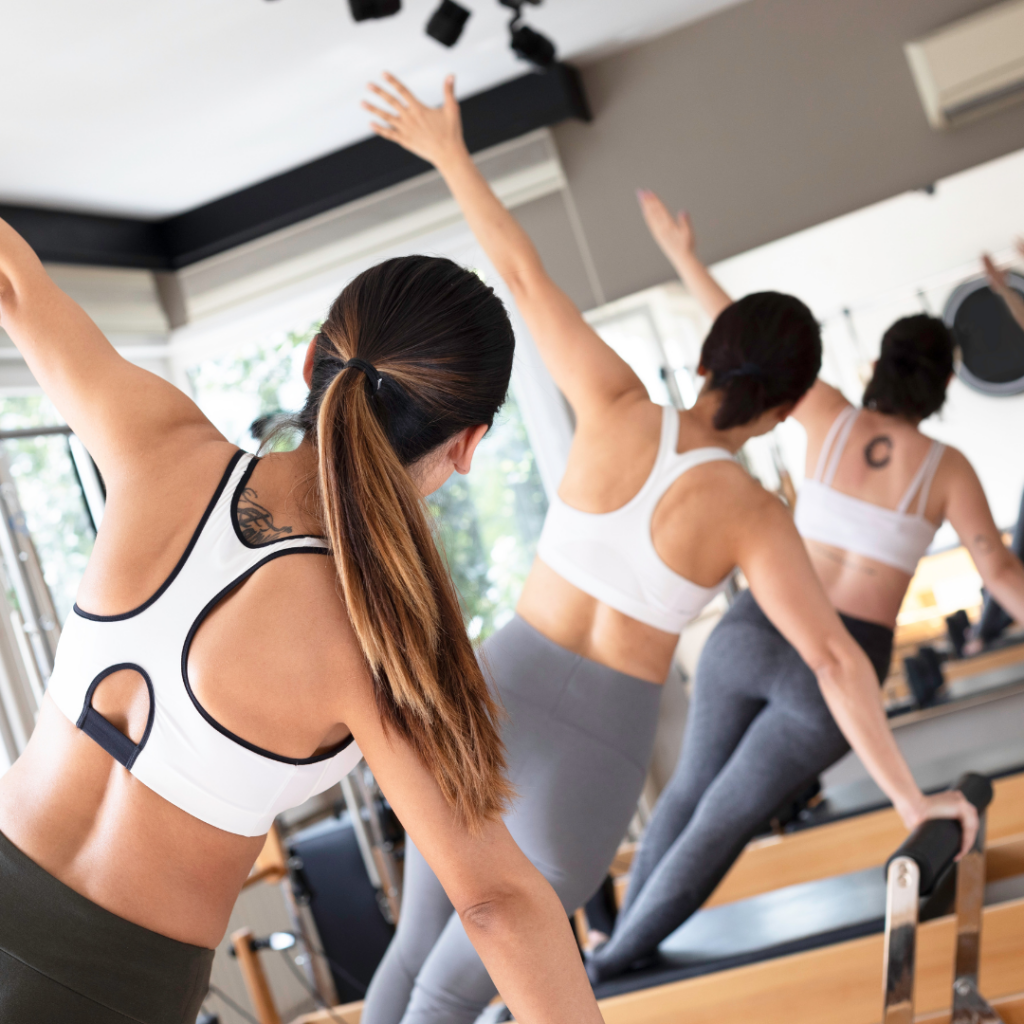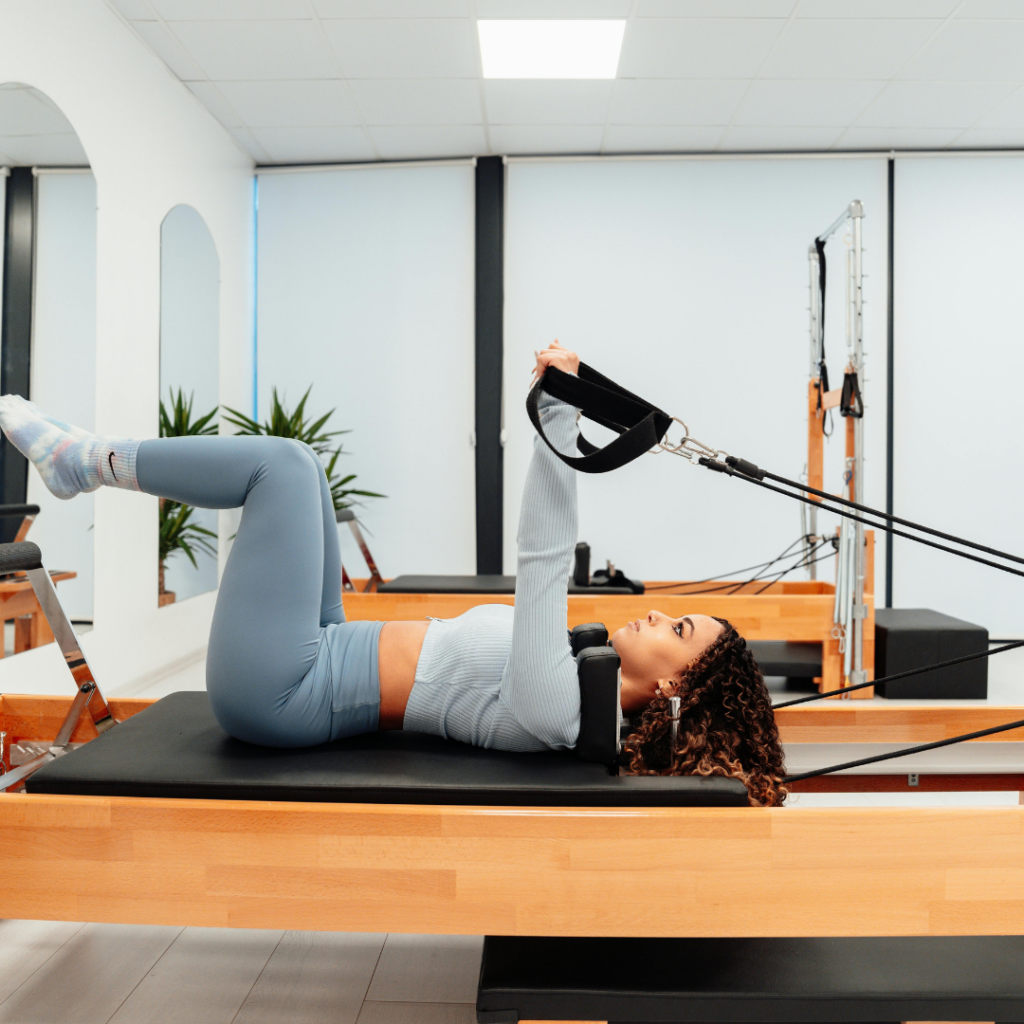What if better posture could help reduce back pain and improve your health? Pilates is a great way to strengthen your core and correct your posture. It can make your back feel better and boost your overall well-being. Let’s dive into how Pilates can help you feel better through core exercises and posture improvement.
Thinking about trying Pilates for back pain? It’s a low-impact exercise that’s easy to adjust to fit your needs and It’s perfect for building core strength and helping fix your posture, and helping to ease back pain.
Understanding the Connection Between Posture and Back Pain
Poor posture can strain the spine, leading to back pain and our posture affects how our spine aligns. When it’s off, it can put pressure on muscles, joints, and discs, causing pain which can affect us in many different ways in our life.
To avoid back pain, maintaining good posture is key and our core muscles, like the abdominals also help assist as well. Weak core muscles can lead to poor posture and back pain so everything is interconnected.
How Poor Posture Affects Your Spine
Poor posture can strain your spine and can lead to added pain. Slouching or leaning to one side can cause uneven pressure which come from spinal alignment, sitting at computers, driving, and different activities throughout the day. Recognizing and correcting these postures can help relieve back pain.
The Role of Core Strength in Maintaining Alignment
Core strength is vital for good posture and preventing back pain when we engage our core muscles it supports our spine and keeps it aligned. This reduces back pain risk, so it’s important to do exercises that strengthen our core muscles for spine health.
Why Pilates is Effective for Back Pain Relief
Pilates is great for back pain relief because it strengthens the core, improves flexibility, and boosts body awareness. It helps build a strong core, which is key for a healthy spine and good posture.
Research shows Pilates is very effective in easing back pain and boosting core strength training. It focuses on the deep muscles of the abdomen and back. These muscles are vital for keeping the spine straight and preventing pain.
Pilates is also great for improving posture correction with exercises that help fix muscle imbalances that cause back pain. It strengthens the core and increases flexibility with consistent practice and you may notice a reduction in pain and increase in mobility soon after starting. This helps people keep a good posture and lowers the chance of back pain.
The Core Principles of Pilates for Spinal Health
Pilates core principles are key for spinal health. Adding spinal health exercises to your routine boosts your well-being while also the Breathing techniques in Pilates engage core muscles and promote relaxation.
Good breathing is vital for spinal alignment as It stabilizes the spine and keeps posture right. Focusing on breathing helps improve spinal health and lowers back pain risk. Also, using your powerhouse muscles is crucial for spine support and posture.
Moving with control and precision is essential in Pilates. This prevents injuries and makes exercises work better and It helps keep your spine healthy and strong.

Using these core principles in Pilates can greatly improve your spinal health. Focus on breathing, engage your powerhouse, and move with precision. This way, you’ll get the best from your spinal exercises.
Essential Pilates Equipment for Back Pain Management
Managing back pain with Pilates is great on the mat or with equipment. While you can do Pilates with little gear, some tools can really help like the Reformer and Cadillac which these apparatuses are also great to assist with healing. They let you move in a controlled way and adjust exercises to ease spine strain.
Using the right Pilates equipment and home workout gear is a big step towards managing back pain. Always listen to your body and adjust exercises to avoid making things worse.
Fundamental Pilates Exercises for Better Posture
Starting your Pilates journey is exciting. It’s key to begin with basic exercises that boost your posture. Pilates exercises for beginners are gentle and easy to start with and they help you build a solid base for more complex moves.
Building Strength and Flexibility
As you get better at Pilates, you can try progressive movement patterns. These patterns help you get stronger and more flexible. This, in turn, improves your posture and lessens back pain.
Always pay attention to how your body feels. Adjust the exercises to fit your fitness level modifications. This keeps your practice safe and effective.
Modifying Exercises for Different Fitness Levels
Pilates is great because you can change the exercises to match your fitness level. Whether you’re new or advanced, you can tailor the workouts to meet your needs. By doing Pilates exercises for beginners and progressive movement patterns, you can enhance your posture and well-being.
Advanced Pilates Sequences for Back Pain Relief
As you get adapt at Pilates, advanced Pilates sequences can really challenge you. They help you relieve back pain by strengthening your core which will make your body stronger and improves your posture one day at a time.
Challenging workouts like these sequences build your endurance. They make your body better at handling stress and strain. This reduces the chance of injury and discomfort.
To do these sequences right, focus on proper form and technique. Working with a qualified instructor or using online resources can help.
Combining Pilates with Daily Posture Habits
It’s also key to practice good daily posture habits all day, not just during workouts. This way, you make Pilates more effective and keep your spine healthy.
Good workspace ergonomics is important for daily habits. A well-set workspace can lower back pain and improve posture. Adjust your chair, monitor, and keyboard to keep your spine straight and avoid neck or back strain.
Also, the way you sleep affects your spine. Sleeping on your back with a pillow under your knees or on your side with a pillow between your knees supports your spine’s natural curve.
By mixing Pilates with these habits, you boost your workouts’ benefits. It’s about a complete wellness plan that includes exercise and daily habits.
Common Mistakes to Avoid in Pilates Practice
Starting your Pilates journey means knowing common mistakes. These can slow your progress and raise injury risks. By avoiding these, you ensure a safe, effective workout. This helps improve your posture and ease back pain.
One big mistake is not engaging your core. This can cause poor form and strain muscles. Avoiding injury is key. Focus on a stable core and controlled movements to stay safe.
Not listening to your body is another error. It can lead to overexertion and injury. It’s vital to know your limits and take breaks to avoid fatigue. Being aware of these mistakes helps create a safe, effective practice for your well-being.
Following practice tips and avoiding common mistakes leads to a successful Pilates practice. Stay focused, listen to your body, and prioritize proper form. This way, you’ll get the most from your workout and reach your goals.
Creating Your Personal Pilates Routine
To get the most out of Pilates, it’s key to create a personal Pilates routine that suits your life and goals. This means scheduling workouts at times that fit your schedule, like early morning, lunch, or evening. This way, you can stay consistent and work towards your health goals.
As you build your routine, tracking progress is vital to see how your body reacts to the exercises. You can do this by noting your workouts, like the exercises, how many times you repeat them, and how you feel after. Tracking your progress helps you see what needs work and adjust your routine as needed.

Remember, the secret to a great personal Pilates routine is being consistent and patient. With regular practice and keeping an eye on your progress, you’ll enjoy Pilates’ many benefits. These include better posture, less back pain, and improved fitness overall.
When to Seek Professional Guidance
Starting your Pilates journey? Knowing when to seek Pilates professional guidance is key. It helps prevent injuries and ensures you get the most from your practice. If you’re new, unsure about form, or have health issues, getting help from a qualified instructor is a good idea.
Getting professional guidance lets you address specific needs or concerns. You can practice safely and effectively. This is especially true for injury prevention. A qualified instructor can adjust exercises to fit your fitness level and health.
Remember, seeking help shows strength, not weakness as it shows your dedication to health and fitness. With the right Pilates professional guidance, you can enjoy a safe and effective practice. You’ll get to enjoy all the benefits Pilates has to offer.
Transform Your Spine Health Through Regular Practice
Improving your spine health through Pilates is a journey worth taking with regular practice that yield lasting results. It brings many benefits, like better posture and less back pain.
Being consistent is crucial for Pilates success and when you make time you’ll feel stronger, your spine will align better, and you’ll feel more well.
Your journey to better spine health is lifelong. Pilates can be your guide. Enjoy the journey, celebrate your wins, and know each session brings you closer to a healthier spine. Start now and see your body’s full potential with Pilates.
Want to receive notifications about Pilates Classes Click here
Stay Connected and Enhance Your Well-Bing
- Explore More Free Resources: Wellness Resources
- Contact Us: info@clarissabooker.com
- Watch on YouTube: Clarissa Booker
Stay connected with us for tools, resources, and support on your holistic wellness journey!